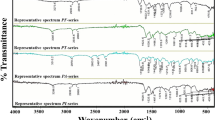Summary
The thermal properties of trans-polynorbornene, cis-polynorbornene and hydrogenated polynorbornene were examined and its reversibility tested. Trans-polynorbornene samples, formed in various solvents, exhibit a softening range, from ambient temperature until 375 °C. However, syndiotactic cis-polynorbornene samples show a narrower melting range (between 150 and 375 °C). The fusion enthalpies of cis-polynorbornene samples are around 300-400 J/g. The temperature of decomposition is ca. 456 °C (minimum peak DSC) for trans-polynorbornene and ca. 466 °C, 10 °C higher, for cis-polynorbornene. The solvent used for the polymerization of norbornene has a negligible influence in the melting temperature range or in the decomposition temperature. The treatment with 2,6-di-tert-butyl-4-methyl-phenol during the isolation of polynorbornene leads to materials with different thermal properties. Trans-polynorbornene isolated without 2,6-di-tert-butyl-4-methyl-phenol exhibited an exothermic peak accompanied by an slight increase in weight (1-2%), while samples treated with 2,6-di-tert-butyl-4-methyl-phenol do not show these features.
Similar content being viewed by others
References
Ivin KJ, Mol JC (1997) Olefin Metathesis and Metathesis Polymerization. Academic Press, San Diego
Grubbs RH, Tumas W (1989) Science 243:907
Schrock RR (1993) Ring-Opening Metathesis Polymerization. In: Brunelle DJ (ed) Ring-opening polymerization: mechanism, catalysis, structure, utility. Munich, New York, pp 130-156
Ohm RF (1980) Chemtech 10:183
Marbach A (1989) Rubber world June:30
Galiatsatos V (1999) Poly(norbornene). In: Polymer Data Handbook. Oxford University Press, pp. 698-700
Dräxler A (1988) Polyalkenylenes. In: Bhowmick AK, Stephens HL (ed) Handbook of Elastomers: Marcel Dekker, Inc pp. 661-693
Michelotti FW, Keaveney WP (1965) J Polymer Science: Part A 3:895
Cataldo F (1994) Polymer International 34:49
Al-Samak B, Ebrahimi VA, Carvill AG, Hamilton JG, Rooney JJ (1996) Polymer International 41:85
Feast WJ, Harrison DB (1991) Polymer 32:558
Al Samak B, Amir-Ebrahimi V, Corry DG, Hamilton JG, Rigby S, Rooney JJ, Thompson JM (2000) J Mol Catal A: Chem 160:13
Cobo N, Esteruelas MA, González F, Herrero J, López AM, Lucio P, Oliván M (2004) J Catal 223:319
Brumaghim JL, Girolami GS (1999) Organometallics 18:1923
Denisov ET, Khudyakov IV (1987) Chem Rev 87:1313
Abboud W, Revillon A, Guyot A (1989) New Polymeric Mater 1:155
Lee L-BW, Register RA (2005) Macromolecules 38:1216
Author information
Authors and Affiliations
Corresponding author
Rights and permissions
About this article
Cite this article
Esteruelas, M., González, F., Herrero, J. et al. Thermal properties of polynorbornene (cis- and trans-) and hydrogenated polynorbornene. Polym. Bull. 58, 923–931 (2007). https://doi.org/10.1007/s00289-007-0734-4
Received:
Revised:
Accepted:
Published:
Issue Date:
DOI: https://doi.org/10.1007/s00289-007-0734-4




